We all want a healthy lawn, but do you think about the health of the soil in your lawn?
A lush and green lawn requires nutrient dense soil, so it’s best to understand which nutrients are present and which aren’t. By educating yourself about soil composition, drainage, acidity and overall soil health, you can avoid the unsatisfactory results that come with unsuitable soil.
This blog outlines four simple lawn soil testing methods that are ideally conducted during your garden’s most active growing period, in spring. Try them in different spots to get the best overall picture of your lawn’s health.
Gardening Tips: DIY Lawn Soil Tests to Get Green Grass
Here are some quick lawn soil tests that homeowners can conduct themselves.
1. Testing Composition

All soil can be classified into three types: sand, clay and silt in different proportions.
Sand drains quickly and doesn’t retain moisture or nutrients. Clay is rich in nutrients but drains very slowly. Loamy soil is generally considered the ideal type as it can retain both moisture and nutrients without becoming soggy.
The best way to test your soil’s composition is to pick up a handful of moist soil and gently squeeze it. Make sure it isn’t wet. If it holds its shape and crumbles slightly when poked, your soil is well-balanced; if it falls apart when you open your hand, your lawn has sandy soil. However, if the soil turns into a firm ball that doesn’t crumble, even when you poke it, your soil is clayey.
Once you know what type of soil your lawn has, you can take measures to improve it to ensure a healthier lawn.
2. Testing Compaction

Ideal lawn soil has 50% pore space and 50% solids. The pore space is vital for passing oxygen and water to the turf along with other microbes, plants and animals that live in the soil. As the soil becomes compacted, the amount of pore space decreases which makes it difficult for the roots of plants and trees to grow.
Typically, properties where new homes have been built nearly always have issues with compaction as heavy equipment is used. However, soil can become compacted thanks to other factors such as walking on it or parking a car. This is one of the main reasons why grass has difficulty growing in these areas.
Fortunately, there is a simple yet effective method homeowners can use to measure how compacted their land is. Simply plunge a wire into the soil vertically at various points and mark the depth where it bends. The more compacted the soil is, the sooner the wire will bend. Ideally, having about a foot of soil that is easily penetrable is suitable for growing grass. Compacted soil isn’t, as it prevents the roots from growing properly and inhibits water availability. This can also keep earthworms and other vital organisms from moving around freely.
3. Testing Drainage

Homeowners can determine whether their property has drainage problems by using the percolation lawn soil test. Wait for the ground to be well-thawed and test a few different areas by digging holes about 12 inches deep and wide. Then, fill them with water. Once the water is drained, fill it again and measure the depth using a ruler. Wait for 30 minutes and measure again to see how much water has drained. The ideal drainage rate is between one to two inches an hour, although a half to an inch of water is adequate.
4. Testing pH Level

To ensure a healthy lawn it’s also important to check the soil’s acidity (pH) level. Tested on a scale of zero to 14, this determines how the grass grows.
Soil with a pH of zero is very acidic; closer to 14 is alkaline. A neutral pH level (between six and seven) is best for plant growth. It’s difficult for grass to grow properly in soil with a pH higher than eight or lower than five.
Soil pH testing kits are widely available at garden centres, but follow their instructions carefully. Once you’ve figured your soil’s pH, you can work towards determining other problems and how to correct them.
Doing these simple tests is an inexpensive way to understand the quality of your lawn’s soil and get the healthy and beautiful lawn you want. Combined with daily observations, these simple soil tests help ensure that your lawn has the best foundation for ongoing growth.

